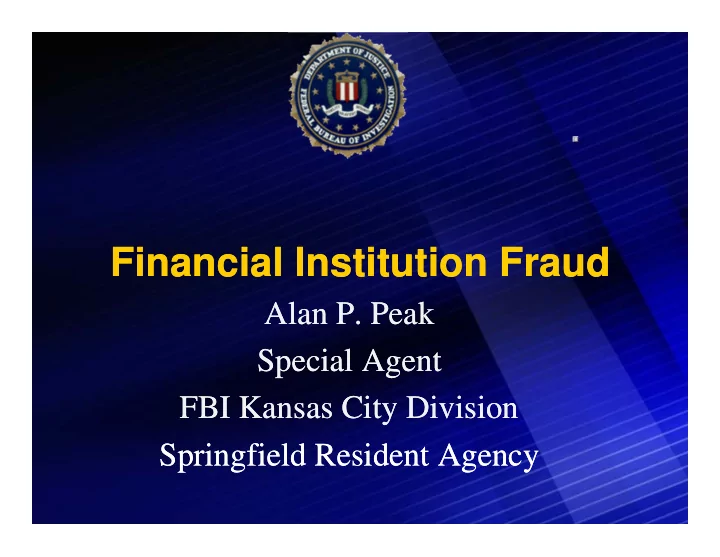

Financial Institution Fraud Financial Institution Fraud Alan P. Peak Alan P. Peak Special Agent Special Agent FBI Kansas City Division FBI Kansas City Division Springfield Resident Agency Springfield Resident Agency
Financial Institution Fraud Financial Institution Fraud Federal Jurisdiction Federal Jurisdiction • Scheme to defraud • Scheme to defraud • Federally insured financial institution • Federally insured financial institution
Financial Institution Fraud Financial Institution Fraud Common Schemes Common Schemes • Misapplication and Embezzlement • Misapplication and Embezzlement • Bad Loans/Improper Lending • Bad Loans/Improper Lending • Check Fraud • Check Fraud – Altered Checks – Altered Checks – Counterfeit Checks – Counterfeit Checks • ACH Fraud • ACH Fraud • Closed Account Fraud • Closed Account Fraud
Financial Institution Fraud Financial Institution Fraud Credit Card Fraud Credit Card Fraud • Stolen Credit Cards • Stolen Credit Cards • Counterfeit Credit Cards • Counterfeit Credit Cards
Financial Institution Fraud Financial Institution Fraud Credit Card Fraud Credit Card Fraud • Hacking • Hacking • Skimming • Skimming • Recruiting • Recruiting • Phishing • Phishing
ACH Fraud ACH Fraud • According to NACHA statistics, the number of • According to NACHA statistics, the number of ACH network payments reached 15.6 billion in ACH network payments reached 15.6 billion in 2010, worth more than $31.7 trillion 2010, worth more than $31.7 trillion • Payroll fraud is among the latest threats to ACH • Payroll fraud is among the latest threats to ACH payments. This is generally accomplished payments. This is generally accomplished through a combination of ACH Fraud, social through a combination of ACH Fraud, social engineering and computer hacking. engineering and computer hacking.
ACH Fraud ACH Fraud • How does ACH Fraud happen? • How does ACH Fraud happen? – Generally accomplished through a targeted – Generally accomplished through a targeted phishing email which tricks the victim into running phishing email which tricks the victim into running malicious software, thereby installing keylogging malicious software, thereby installing keylogging software. software. – Many larger schemes use “mules” who are hired – Many larger schemes use “mules” who are hired accomplices, usually through work-at-home accomplices, usually through work-at-home schemes, to knowingly or unknowingly move schemes, to knowingly or unknowingly move funds to overseas accounts. funds to overseas accounts.
ACH Fraud ACH Fraud • Who is at risk? • Who is at risk? – FBI analysis has found in most cases, the victims’ – FBI analysis has found in most cases, the victims’ accounts are held at local community banks and accounts are held at local community banks and credit unions, some of which use third-party credit unions, some of which use third-party service providers to process ACH transactions. service providers to process ACH transactions. – The account holders are often small to – The account holders are often small to medium sized business, in addition to court medium sized business, in addition to court systems, school districts, and other public systems, school districts, and other public institutions. institutions.
ACH Fraud ACH Fraud • What are some best practices to avoid ACH • What are some best practices to avoid ACH Fraud? Fraud? – Detection is key. Consumers need to alert – Detection is key. Consumers need to alert their institution within 60 days in order to their institution within 60 days in order to recover funds. Businesses, however, only recover funds. Businesses, however, only have as little as one business day. have as little as one business day. – ACH Blocks, ACH Filters and Positive Pay – ACH Blocks, ACH Filters and Positive Pay
Identity Theft Identity Theft Involves the misuse of another individual’s Involves the misuse of another individual’s personal identifying information for fraudulent personal identifying information for fraudulent purposes purposes
Identity Theft Identity Theft • Almost always committed to facilitate other • Almost always committed to facilitate other crimes, such as credit card fraud, mortgage crimes, such as credit card fraud, mortgage fraud, and check fraud fraud, and check fraud • FBI investigations reveal the majority of illicit • FBI investigations reveal the majority of illicit proceeds derived from Identity Theft are used to proceeds derived from Identity Theft are used to purchase illegal drugs, pay established debt, purchase illegal drugs, pay established debt, purchase cars, real estate or furniture, for purchase cars, real estate or furniture, for gambling or prostitution. gambling or prostitution.
Identity Theft Statistics Identity Theft Statistics • • A survey conducted by the Federal Trade Commission (FTC) A survey conducted by the Federal Trade Commission (FTC) in 2006 estimated that 8.3 million American consumers, or in 2006 estimated that 8.3 million American consumers, or 3.7% of the adult population, became victims of Identity Theft 3.7% of the adult population, became victims of Identity Theft in 2005. The same survey determined that victim consumers in 2005. The same survey determined that victim consumers spent over 200 million hours in 2005 attempting to recover spent over 200 million hours in 2005 attempting to recover from Identity Theft. from Identity Theft. • • Identity Theft losses estimated at $15.6 billion in 2005. Identity Theft losses estimated at $15.6 billion in 2005. • • 56% of victims don’t know how their information was taken. 56% of victims don’t know how their information was taken. Among those who knew how their information was taken, Among those who knew how their information was taken, most common was that their information was stolen by most common was that their information was stolen by someone they personally knew. someone they personally knew.
Questions Questions Special Agent Alan P. Peak Special Agent Alan P. Peak Federal Bureau of Investigation Federal Bureau of Investigation 1932 W Chesterfield Blvd, Suite 200 1932 W Chesterfield Blvd, Suite 200 Springfield, MO 65807 Springfield, MO 65807 (417) 890-2452 (417) 890-2452
Recommend
More recommend